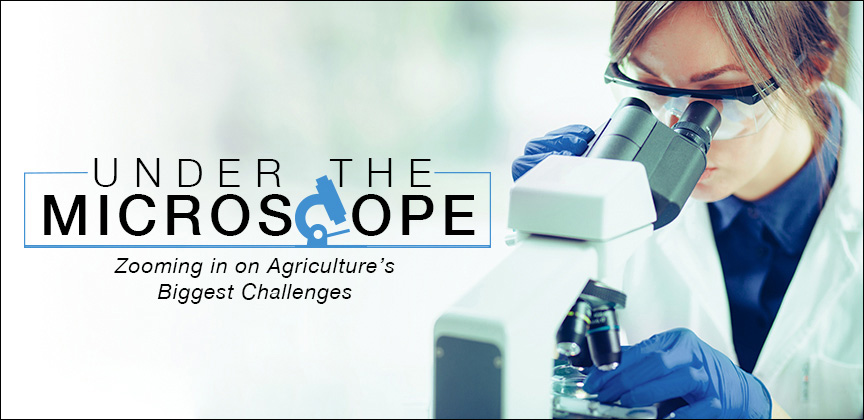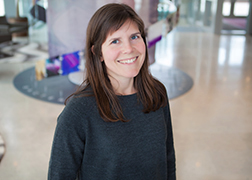
Rising Ozone Pollution and Agriculture: A Stratospheric Challenge for Growers
 |
Lisa Ainsworth is a plant physiologist at ARS's Global Change and Photosynthesis Research Unit in Urbana, Il, who studies how two global climate changes — rising carbon dioxide concentration and rising tropospheric ozone concentration — directly affect crop productivity. Dr. Shuai Li, who works closely with Dr. Ainsworth at the University of Illinois in Urbana-Champaign, contributed to the responses. |
Welcome back to Under the Microscope, Dr. Ainsworth.
UM: What is ozone pollution and why is it an issue?
LA: Ozone (O3) is a gas composed of three atoms of oxygen and is a highly reactive molecule, among the most powerful oxidizing agents known. In the stratosphere, the upper atmosphere of the earth, ozone filters the sun's ultraviolet (UV) radiation, thereby protecting living organisms from UV exposure. However, in the troposphere, the part of the atmosphere where we live and breathe, ozone is toxic to plants, animals, and human beings. Breathing air with high concentrations of ozone can trigger a variety of respiratory and cardiovascular problems and reduce lung function. Tropospheric ozone is well recognized to have negative impacts on plant growth and development, resulting in a substantial loss of crop productivity and yield, as well as terrestrial plant productivity worldwide.
UM: What is it caused by?
LA: Tropospheric ozone is formed by a series of complex reactions between volatile organic compounds (VOCs) and nitrogen oxides (NOx) in the presence of heat and sunlight. Ozone production is directly related to the amount of chemical emissions from vehicles, factories, and many other industrial sources, fossil fuel combustion, biomass burning, consumer products, evaporation of paints and hairspray, and a lot of the things we do and use every day. Ozone concentrations have more than doubled in the Northern Hemisphere from pre-industrial levels of 10 to 15 ppb (parts per billion) to a current concentration of approximately 40 to 50 ppb. However, ozone concentrations are predicted to increase due to expected rise in ozone precursor emissions in the future.
UM: How does ozone pollution tie into climate change, specifically rising carbon dioxide concentrations?
LA: Tropospheric ozone is the third most important anthropogenic (caused by human activity) greenhouse gas preceded by carbon dioxide (CO2) and methane (CH4). Like all greenhouse gases, ozone absorbs some of the infrared energy (heat) emitted by the earth and reduces the amount of radiation that escapes to space, thereby contributing to global warming.
UM: Can the effects of ozone pollution be reversed?
LA: The lifetime of ozone in the troposphere is relatively short, just a few weeks on average. Therefore, reducing the precursor emissions can reduce ozone concentrations immediately.
UM: Why are high ozone pollution concentrations more prominent in some regions, like the United States, but not in others?
LA: Due to emissions from vehicles and industrial activities as the primary source of ozone precursors, ozone pollution is most common in densely populated metropolitan cities, such as Los Angeles, San Diego, Phoenix, Houston, New York and Denver. Ozone pollution has become a severe environmental problem in many developing countries like India and China, where rapid urbanization and industrial development emit high levels of ozone precursor pollutants.
Biogenic VOCs emitted from forests and agricultural crops are also a source of ozone precursor gases. Both ozone and ozone precursors (e.g. NOx and VOC emissions) can travel hundreds or even thousands of miles on air currents, affecting areas far from the pollutant source. Overall, many of the major cities and most productive agricultural areas in the world are exposed to high levels of ozone pollution.
UM: Do you expect it to get worse?
LA: Although ozone concentrations have decreased in the eastern United States and parts of Europe over the past 20 years due to reductions of anthropogenic emissions, ozone pollution will likely continue to worsen in most of the countries in Asia and may parts of Europe and North America.
UM: Okay, let’s dive into your research. What have you found with regards to how crops tolerate ozone pollution?
LA: In our study, we found that crops with different carbon-fixation pathways exhibit different sensitivities to ozone pollution. Specifically, C4 crops including sorghum, maize, and switchgrass tolerate increased ozone levels better than C3 crops, including chickpea, rice, snap bean, soybean, and wheat. In addition, inbred and hybrid lines of rice and maize also showed different sensitivities to ozone exposure.
UM: Your research shows that hybrid line crops tend to be more sensitive to elevated ozone levels than inbred lines. Why is that?
LA: I think ozone response mechanisms in inbreds and hybrids are different between rice and maize. In general, we believe that stomatal conductance (i.e., water loss through the leaf stomata) is a major factor determining plant ozone sensitivity. This is true for maize because hybrid lines with greater stomatal conductance showed a larger decrease in photosynthesis and more grain yield loss compared with inbred lines. But this may not be true for rice because both rice inbreds and hybrids showed a similar range of stomatal conductance but different ozone sensitivity. In rice, reduced tiller and flower numbers and less efficient antioxidant metabolism could be a reason for greater ozone sensitivity in rice hybrids.
UM: How will this research affect how our breeders develop new cultivars for our fruits and vegetables?
LA: Although high productivity is the main target for breeders when breeding new varieties of crop, the capacity of crops to cope with not only ozone pollution but also other stresses in an increasingly warmer climate is also crucial to maintain high yields.
UM: This seems like a part now, part later solution, where we identify crops currently in use that are tolerant to ozone pollution while starting to breed new lines that are not as susceptible to ozone pollution. Is that the goal of your research?
LA: Yes — the ‘now’ part is that we have identified C4 species that are ozone tolerant. The ‘later’ part is that we need to breed for better ozone tolerance in C3 crops.
UM: : In addition to the breeding aspect, you recommend that farmers and growers use climate smart agricultural practices. Can you give a few examples?
LA: Any practice that reduces the greenhouse gas burden of agriculture is a climate smart practice. These potentially include cover crops, minimum or no tillage, planting bioenergy crops, reducing fertilizer inputs, etc.
UM: What advice do you have for farmers and growers, to deal with the challenges related to ozone pollution and climate change?
LA: In addition to breeding new crop varieties with high ozone tolerance, screening of existing crops for their tolerance to ozone is a crucial step before planting. Because ozone is a secondary pollutant formed from reactions with nitrous oxides and volatile organic compounds, reducing emissions from agriculture can also protect crops from ozone stress.
UM: : Can farmers and growers help reduce ozone pollution?
LA: Yes, sustainable practices adopted by farmers and growers can help to reduce ozone pollution. For example, using a diverse cropping mosaic or diversifying crop rotations and reducing fertilizer application will help improve soil health and reduce greenhouse gas emissions from soil. Minimizing or avoiding biomass burning in the open field is an effective way to reduce ozone precursors.
UM: : Can everyday people help reduce ozone pollution?
LA: Of course! People can get involved in reducing ozone pollution every day. For example, using public transportation or electric vehicles are good ways to reduce emissions and maintain air quality. In the case of gas-powered vehicles, properly maintaining vehicles generates less air pollution. When the weather is good and/or the air is healthy, you can walk or bike to your destination.
You May Also Like:
